Whitby: Town of Voyagers and Vampires
by Jane Gilbert
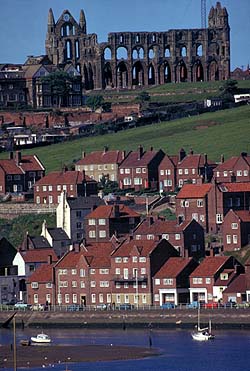 Visitors to Whitby can't
escape its quintessential Britishness. From fish and chips to
rainy picnics, this small fishing town on the north east coast
embodies England's fast disappearing seaside tradition. While the
Victorian grandeur of Plymouth and Torquay decays along rusting
piers and dreary promenades, Whitby's vitality and freshness can
be sensed throughout its cobblestone streets. Visitors to Whitby can't
escape its quintessential Britishness. From fish and chips to
rainy picnics, this small fishing town on the north east coast
embodies England's fast disappearing seaside tradition. While the
Victorian grandeur of Plymouth and Torquay decays along rusting
piers and dreary promenades, Whitby's vitality and freshness can
be sensed throughout its cobblestone streets.
First colonised in the fifth century A.D, Whitby witnessed a
vital turning point in the history of the English church. The
cliff top Abbey, founded in 657 A.D., was the site of an early
Synod Council in 664, where the Celtic and Roman churches tussled
over the date of Easter. King Oswiu decided in favour of Rome.
After all, it is St Peter who holds the keys of heaven. His
decision brought the English church into close contact with the
rest of Europe.
English poetry also sprung from Whitby. The ploughboy Caedmon,
acclaimed as the first poet in the English language, died there
in 680 A.D.
The abbey was destroyed by Vikings, but rebuilt in 1077. You can
see echoes of the medieval gothic style in today's ruins.
In the 1700s the town became an important whaling port. The two
jaw bones of the West Cliff Arch, a reminder of Whitby's whalers,
tower above you. But the sixteen foot, three hundred and fifty
pound bones you see today are not as old as you might think. In
2002, it was noticed that the whalebone arch was decaying. Help
came from Whitby's sister city of Anchorage, Alaska, who
presented the town with a new set of blue whale bones to
commemorate the 25th anniversary of their relationship.
One of Whitby's most famous sons is Captain James Cook, the
18th-century explorer who discovered Australia. He was
apprenticed to a Whitby ship-owner at the age of eighteen. His
first voyage was on the cargo ship The Freelove, carrying
coal from the north down to London. The dangerous, ill-marked
North Sea waters offered the splendid practical training that
allowed Cook to confront dangers from the Antarctic to the Great
Barrier Reef. He rose through the merchant ranks, taking
advantage of the winter months of refitting to study mathematics
by night.
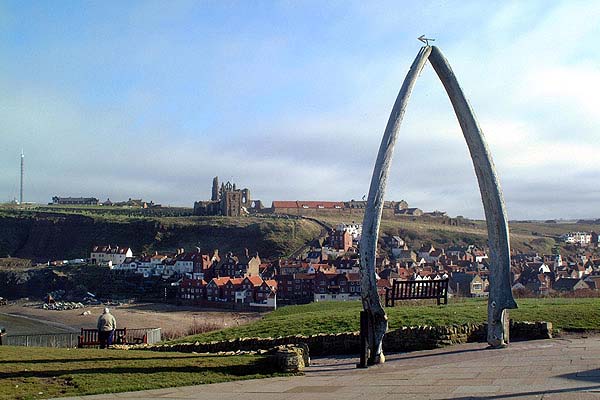
Seeking wider prospects in the Royal Navy, Cook's valuable
seafaring experience and leadership qualities saw him posted to
America, where he protected British colonial interests against
the French during the Seven Years War. He proceeded to make his
name as a cartographer, mathematician and astronomer.
Nonetheless, when the Admiralty organised the first scientific
expedition to the Pacific in 1768, Cook, now forty, was a
surprise choice as commander. In a plain but dependable coal-bark
from Whitby, renamed HMS Endeavour, Cook successfully
dropped off Royal Society botanists, astronomers and artists in
Tahiti, thus establishing the tradition of ship-board scientists
that saw Charles Darwin sail on his landmark expedition on The
Beagle.
Next, Cook headed south-southwest in search of Terra Australis,
at that time a mere cartographic conjecture. Not only did he find
and chart New Zealand, he successfully navigated and surveyed the
world's toughest navigational hazard -- the Great Barrier Reef --
and returned to England with remarkably few losses, notably none
to scurvy. Cook demanded cleanliness and ventilation in the
crew's quarters and a diet including greenstuffs and citrus. His
sailors' health made him a naval hero.
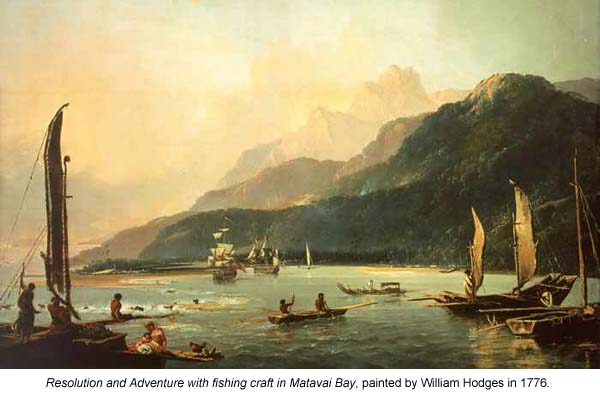
Cook went on to explore the South Seas in another Whitby ship,
The Resolution, discovering many islands that remain
British possessions to this day. After an unsuccessful search for
the Northwest Passage, he was killed in Polynesia, but not before
he met the king, was made a captain, and was elected with highest
honours to the erudite Royal Society for defeating scurvy.
Visitors can relive the past on a replica of the Endeavour which
carries tourists on excursions into the bay, while the Grape Lane
house where he lived houses the popular Captain Cook Museum.
One of the most popular souvenirs to take home is a trinket made
from the unique Whitby black jet stone. Formed from the remains
of a tree from the Jurassic Period, the stone is only found along
one stretch of Whitby coastline. Another essential memento is a
print from Victorian photographer Frank Meadow Sutcliffe. From
fisherman hauling in the day's catch to moony-eyed children
playing on the beach, the images from Whitby's heyday offer a
remnant of a town with history dripping from every building.
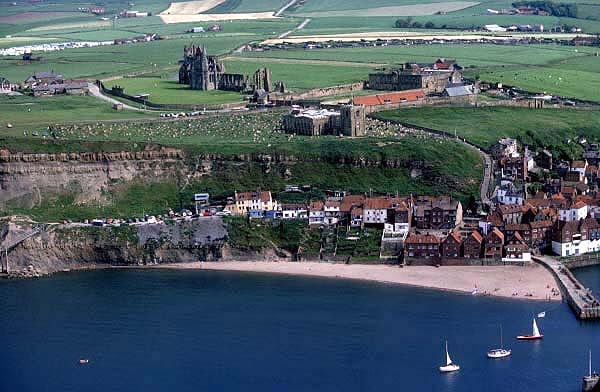
You can't walk far along the winding streets, however, before you
notice what Whitby is most famous for. Vampire myths are found in
cultures all over the world and have been the inspiration for
spine-chilling legends and innumerable films. But the most famous
vampire of all, without a shadow of a doubt, was created by
Victorian writer Bram Stoker. Count Dracula may have his roots
firmly in Eastern Europe, but in Stoker's story he visits a small
seaside resort on England's north-east coast in search of British
blood. After all, even vampires need a holiday.
The infamous Count is around every corner and in every shop
window. And, despite his gruesome taste for blood, Dracula has
brought fresh life to this windswept part of Britain -- in the
shape of tourism.
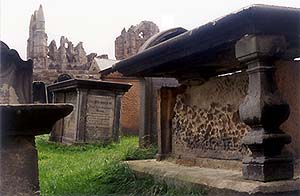 In the early 1890s, when
Bram Stoker was writing his famous novel, Whitby was a thriving
port and fishing town. It was also an increasingly popular
seaside resort for wealthy and fashionable Victorians. When the
fishing industry began to decline in the later part of the
twentieth century, Whitby survived because of its popularity with
tourists. Bram Stoker often took his holidays here. He stayed in
The Duke of York, a riverside inn, whilst working on the
novel. In the early 1890s, when
Bram Stoker was writing his famous novel, Whitby was a thriving
port and fishing town. It was also an increasingly popular
seaside resort for wealthy and fashionable Victorians. When the
fishing industry began to decline in the later part of the
twentieth century, Whitby survived because of its popularity with
tourists. Bram Stoker often took his holidays here. He stayed in
The Duke of York, a riverside inn, whilst working on the
novel.
Locals tell the tale that pigeons perched on the window ledge of
Stoker's room, pecking away with their beaks at their own
reflections in the glass. They say this found its way into the
novel when the Count's nails scrape against Lucy's window as he
tries to get in, hellbent upon making her one of the undead.
In Stoker's novel, after the shipwreck of The Demeter,
Dracula runs up the famous 199 steps to the graveyard in St
Mary's church in the shape of a black dog. An examination of the
ship's log shows that the crew members had been gradually
disappearing since she left Varna in Russia. But it is the ship's
cargo which gives readers a clue about how Dracula managed to
travel so far without being noticed -- it is full of coffins.
This passage of the novel is based on historical fact. A few
years before Stoker came to Whitby, a ship called The
Demetrius was damaged on the rocks near the harbour. Its
cargo of coffins tumbled into the sea. The locals revelled in
telling yarns about the dead bodies that appeared on the town's
beaches in various stages of decay for weeks after. A bench on
the cliff top path is inscribed with the words 'The view from
this spot inspired Bram Stoker (1847-1912)'.
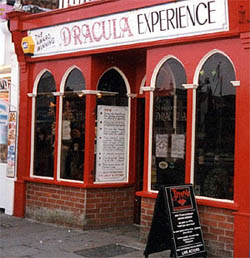 Although if all the hotels, cafes and street corners
laying claim to a Stoker connection are telling the truth, it's a
wonder his book wasn't a thousand pages long. Although if all the hotels, cafes and street corners
laying claim to a Stoker connection are telling the truth, it's a
wonder his book wasn't a thousand pages long.
One tourist attraction less concerned with facts than fun is the
Dracula Experience on the West Cliff. Sinister music attracts the
attention of passers-by. Visitors wander through the darkness
while animated characters re-enact the story, including a Dracula
figure that rises again and again from his coffin. A mix of live
actors and edifying displays create a semi-serious atmosphere of
horror. Whilst you might not emerge shaking with fear, the
Experience certainly offers a lively introduction to Whitby's
Dracula heritage.
Those seeking a more authentic experience, while taking in some
of the town's historical sites, should opt for one of the themed
walks offered by expert local guide, Harry Collett. You can
choose between general ghost tours and dedicated Dracula walks,
as well as more educational options, exploring the town's
maritime history and that of the surrounding countryside. Of
course, it's the Dracula walks which are always the most popular.
'Our fear of vampires,' suggests Harry, 'is as ancient as our
fear of darkness.' Not frightening enough to keep away the two
thousand goths who flock to Whitby each May and November for a
Dracula festival. And tourists are always fascinated by the depth
of Harry's knowledge. The questions he is most often asked are
'Is Dracula still alive?' 'Where is he buried?' and 'Are you
Dracula?
Don't forget to visit the ancient Abbey, even though it will mean
climbing the famous 199 winding steps. I clambered up towards
midnight under a full moon. With the Abbey floodlit orange
against the night sky and the broken tombs and faded inscriptions
of nearby St Mary's church graveyard, the view when you get to
the top is well worth it. Perhaps it was the sound of the sea
crashing into the base of the cliffs, or the shakiness of my legs
after the long climb, but it was easy to imagine Dracula lurking
in every shadow. I certainly felt relieved to get back to the
relative normality of the town.
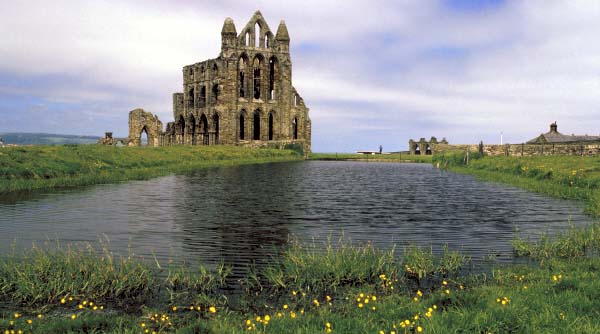
Whitby will continue to cash in on the Dracula connection as long
as the world's most enduring horror novel remains popular. But,
whether you tremble at the top of the 199 steps or laugh at the
models in the Dracula Experience, it really doesn't matter.
Vampires may seem a million miles away when you are chomping away
on traditional British fish and chips by the shore, but there are
enough plastic Dracula souvenirs around to scare anyone.
Related Articles:
- Discovering Whitby Abbey, by John Ravenscroft
- https://www.timetravel-britain.com/articles/churches/abbey.shtml
- Cook's Tour: Exploring "Captain Cook" Country, by Keith Kellett
- https://www.timetravel-britain.com/articles/churches/cook.shtml
More Information:
We regret that we no longer have the resources to maintain up-to-date links and/or hours and pricing details for the various sites and attractions listed on this website. For more information about the location(s) listed above, please use your favorite search engine or visit Wikipedia.
Writer, teacher and psychologist Jane Gilbert comes from Devon, England, and lives by the sea in Italy. After studying English Literature, she ran away to Brazil where she travelled extensively and cuddled sloths. She likes giraffes and curl reviver.
Article © 2006 Jane Gilbert
Dracula Experience photo © Jane Gilbert. Cook painting and graveyard photos courtesy of Wikipedia.org. Whale tusks photo by Ian Britton, courtesy of FreeFoto.com. Additional photos courtesy of Britainonview.com.
| 